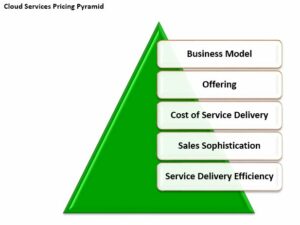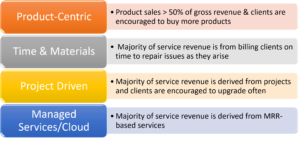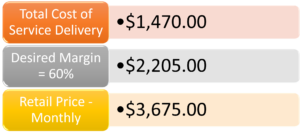No matter how well you design and deliver a managed or cloud service, it won’t make you money – and might even cost you some – if you don’t price it properly. This article delivers proven, actionable advice on how to arrive at the most profitable prices for your service offerings.
Pricing Cloud Computing and Other MRR Services
There are several factors that can affect your pricing methodology for cloud computing and other monthly recurring revenue services. You will need to analyze your business to determine your pricing model depending on factors including, but not limited to:
- Your predominant business model
- The services that comprise your cloud or other MRR offerings
- Your costs to deliver these services
- Your sales sophistication
- Your efficiencies in delivering these services
The less efficient you are at delivering service, the higher your price points must be to maintain your desired net profitability.
Pricing Factors Pyramid


Determining Your Predominant Business Model
Your predominant business model may influence not only your deliverables and how successful you are at marketing and selling them, but also your target markets, customers, vendors, and overall profitability. If your predominant business model is product-centric, you may be challenged when attempting to sell and deliver cloud or other MRR services, as the achievement of success in a more service-centric model requires unique skill sets centered on effective sales and long-term relationship-building and customer satisfaction techniques.
As an example, it is logical to assume that a product-centric or time and materials – based service provider would have a tougher time selling cloud computing solutions and delivering services as efficiently, effectively, and profitably as would a reseller who has already built an effective managed services practice.
IT Provider Predominant Business Models


Determining and Developing a Cloud Services Offering
As each of the three cloud services models offer different solutions and appeal to different end customers and markets, you must determine your specific go-to-market cloud offerings. This will also depend heavily on the vendors and fulfillment partners you align with, and their capabilities, SLAs, and price points. Each cloud services model, whether Software as a Service, Infrastructure as a Service, or Platform as a Service, has its own unique requirements and appeal from provider, end-customer, pricing, complexity, and implementation and maintenance perspectives, and each delivers a different set of solutions.
You must evaluate each of these deliverables carefully and determine which of them, and in what priority, you will incorporate into your solution stack to begin offering to prospects and clients.
Determining True Costs of Service Delivery
Once you have determined your cloud services offerings, the first step in establishing profitable price points for each of these cloud services is to identify your cost of service delivery. In order to accomplish this, you must understand your hourly labor burden, your hourly overhead burden, the number of hours it will require to support your cloud services customers, and your subscription costs for the cloud services you are reselling.
To calculate the labor burden for billable staff, you will divide all of their labor costs, including those above and beyond gross compensation, by 2,080 work hours per year (40 hours per week X 52 weeks). To calculate overhead burden, you will total the yearly amount of all company overhead costs (including indirect labor) and divide that value by 2,080 work hours per year as well. By adding these two values together you can estimate your hourly cost of service delivery.
Once this has been determined, you will forecast the number of hours it will take to support your cloud services customer and multiply that number by your hourly cost of service delivery. The final step for you to determine your total cost of service delivery is to add your costs for 3rd party cloud and other subscription services you are including in your service bundle to the equation, along with any marketing and sales costs expended to acquire your customer.
Determining Service Delivery Costs


Determining Retail Pricing
Once you have established your total cost of service delivery for your cloud services offerings, it’s a simple matter to determine the margin you would like to realize for each of your solutions and set your price points appropriately.
Retail Pricing Example
Conclusion
Pricing managed and cloud services at rates low enough to be competitive yet high enough to maximize your margins is no easy feat. With the help of the guidelines in this article; however, any channel pro can arrive at the right figure for every service he or she offers every time.
Make Pricing Your Services Easy With My MSP MRR Pricing Calculator – Click Here To Get It FREE!
Save
Save








